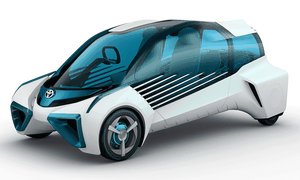Toyota at Tokyo Show - Sporty, Green, Retro and Sci-Fi Concepts

The array reflects the automaker’s desire to build a reputation for style and excitement on top of its status as a master of utilitarian, if ho-hum, rides.
Compact, sporty
 Take the S-FR concept, a two-door sporty coupe with a long hood, rear-slung cabin and gaping front air intake. The sporty runabout is no bigger than the company’s Yaris subcompact, yet seats four. Designers gave it a low and wide stance and tried to create a driver-focused experience with a front mid-engine layout.
Take the S-FR concept, a two-door sporty coupe with a long hood, rear-slung cabin and gaping front air intake. The sporty runabout is no bigger than the company’s Yaris subcompact, yet seats four. Designers gave it a low and wide stance and tried to create a driver-focused experience with a front mid-engine layout.
Toyota bills the concept, which looks remarkably production-ready, as a lightweight, entry-level sporty car with optimal weight distribution and independent suspension for superb cornering. It did not give engine details, but said the car has a six-speed manual tranny.
Toyota says the car would slot below the Toyota 86 sporty coupe. That car, sold as the Scion FR-S in the U.S., was developed with Subaru, which sells its own version as the BRZ.
Miata ties?
The S-FR bears a passing similarity to the Mazda MX-5 Miata. That dangles the possibility of a tempting tie-in, given Toyota’s new alliance with Mazda Motor Corp. But the S-FR’s designer, Koichi Matsumoto, says the concept was done completely in-house with no plans for future collaboration with the smaller Japanese partner.
Indeed, the S-FR is shorter, narrower and taller than the MX-5, though it seats two more people than the Miata.
Matsumoto said he gave it a massive grille to express a sense of sportiness. He described the S-FR’s face as friendly, without digressing into cute.
Its compact, supple look was inspired by a weatherworn round rock, Toyota said. The idea is to express a warm, simple structure that embodies a latent sense of movement.
Green, futuristic
 Toyota turns futuristic with its FCV Plus Concept, a vision of a possible successor to the company’s Mirai hydrogen fuel cell vehicle that went on sale in Japan last year and in the U.S. this year.
Toyota turns futuristic with its FCV Plus Concept, a vision of a possible successor to the company’s Mirai hydrogen fuel cell vehicle that went on sale in Japan last year and in the U.S. this year.
The idea: An evolution from eco-car to “energy car,” or one that can serve as a power source for everything from other vehicles to people’s homes when it is not being driven, by harnessing the electricity created by the car’s hydrogen fuel cell stack.
In the FCV Plus Concept, the fuel stack is downsized and packed between the front wheels, while the hydrogen tank and battery sits between the rear wheels. Four in-wheel motors propel the car, optimizing passenger space for four occupants.
A space-age exterior caps the cabin in a bubble of blue glass and wraps the rear wheels in aerodynamic cladding. The bottom of the vehicle is sculpted to channel air out between the rear wheels through a trapezoidal arch as a sort of jumbo diffuser.
“Toyota’s aim is to add an all-new sense of purpose to the automobile by turning fuel cell vehicles from eco-cars into energy cars,” Toyota said in a statement. “The vehicle can thus be transformed into a stable source of electric power for use at home or away.”
Retro, handcrafted
Another Toyota concept, the Kikai, salutes the company’s roots in monozukuri, the Japanese term for the art and craft of manufacturing. Looking like a Mad Max throwback jalopy with its engine, suspension, frame and wiring exposed, the Kikai revels in the engineering of the automobile much the way a glass-backed Swiss watch shows off its gears.
 Kikai means “machine” in Japanese.
Kikai means “machine” in Japanese.
“Machines should be objects of admiration,” Toyota said. “The Kikai is a concept designed to explore and emphasize the fundamental appeal of machines: their fine craftsmanship, their beauty, their simplicity and their fascinating motion.”
Every detail, from the exhaust pipe to the fuel tank, is lovingly rendered with exquisite detail to showcase the inner beauty normally hidden from view by sheet metal.
To heighten the sense of connection with the road, small windows near the driver’s feet offer a view of the rushing pavement and the bouncing front suspension.
It’s a funky driver-centered car, in the strictest sense. The driver sits alone, centered up front, while two passengers sit behind in a triangular layout.
Cute, chatty
Finally, Toyota offers the Kirobo Mini, a miniaturized version of its Kirobo partner robot.
The larger forerunner of this owl-eyed humanoid automaton holds two Guinness world records, after spending 18 months orbiting Earth in the International Space Station.
 One record is for being the first “companion robot” in space. The other is in recognition of the highest altitude at which a robot has ever had a conversation.
One record is for being the first “companion robot” in space. The other is in recognition of the highest altitude at which a robot has ever had a conversation.
Kirobo’s shtick is keeping people company by “conversing” with them -- that is, responding to casual chitchat through its voice recognition and language processing software. It’s a technology that has captured the public’s imagination in Japan, where a rapidly graying society is generating legions of isolated elderly who might benefit from such companionship.
Still, Toyota thought the grown-up Kirobo’s 34-cm (13-inch) stature was too cumbersome to accompany an on-the-go human. Hence, a 4-inch Kirobo Mini.
The palm-sized co-pilot is just small enough to perch in your car’s cup holder. But don’t expect riveting discourse if you’re driving U.S. highways. Kirobo Mini speaks only Japanese.
